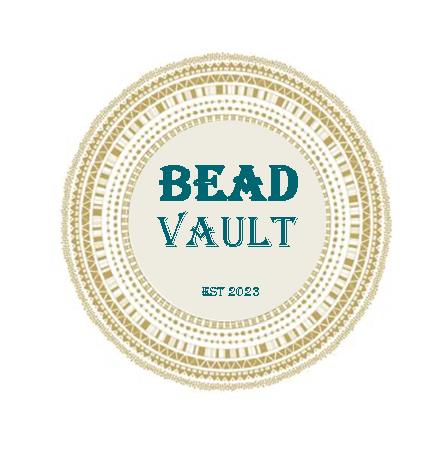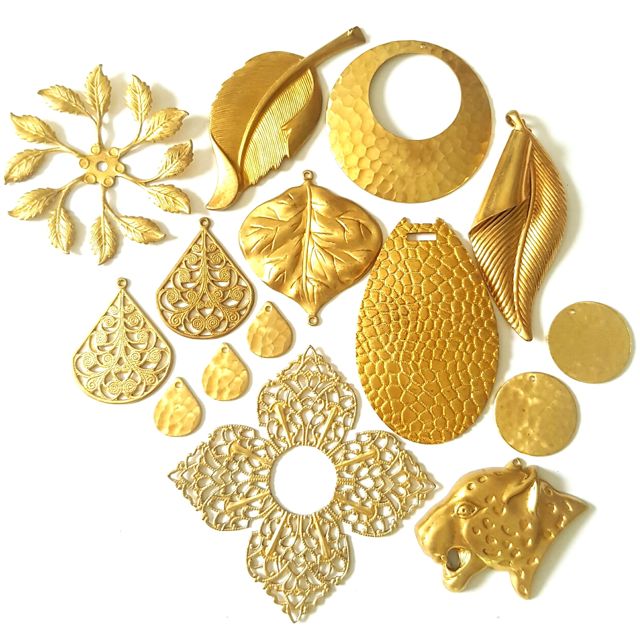How to Use Brass Stampings?
Brass stampings are some of the most versatile pieces to use as a crafter, jewellery maker and jewellery designer.
Designs include filigrees, ornaments and charms and they can be used as:
- Embellishments for beautiful vintage inspired jewellery.
- Links (by themselves or with other findings and beads).
- Pendants or charms for necklaces and chandelier earrings with a fringe or cascade of beads.
- Instant rings and brooches by gluing a brooch back or ring setting.
- Decorative fabergé eggs, scrap booking, millinery, quilting
- Architecture and theatre models, dolls houses.
Why Use Brass as a Jewellery Designer?
- Durability: Brass is highly durable which means it just keeps getting better with age. The more you wear it the better it looks.
- Quality: Brass is solid and is polished easily which means it never peels, chips or fades.
- Wearability: Brass is corrosion resistant which means it will not rust if you love to wear your jewellery at the beach or in the shower.
- Sustainability: Brass is green: a highly machinable material which makes it able to be accurately manufactured with less scrap, less rework, and less energy than other materials. Products made from brass generally have good "cradle-to-grave" characteristics as not only do they show good durability, but brass is also readily recycled at the end of the products working life. Basically, it is the most eco of all metals you can work with.
- Brass is lead and nickel free which means no more sensitive and sore ears!
- Complimentary: Brass has a soft muted honey colouring, which makes it the most complimentary of all metal finishes for most skin tones.
How are Brass Stampings Made?
Thin sheets of brass are imprinted or stamped with dies made by metal engravers to produce delicate charm and "metal lace", known as filigree cut-outs.
The History of Brass Stampings
Used predominately in the manufacture of couture jewellery in the 18 and 19th centuries, brass stampings have once again become extremely popular in contemporary jewellery from centre stage pendants to eclectic charm bracelets and chandelier earrings. Many of the pieces we feature are still made from the original dies inspired by the Victorian period and created in the late 1800's. They were designed and made in France, Bohemia and Italy in the 18th and 19th centuries.
The French philosopher Montaigne, in the 16th century discussed the desire “to put adornment within everybody’s reach”. Praising the work of the metalworkers, he revolutionised the wearing of jewellery, as it now became accessible not only to the privileged rich, but to the common people. Used predominately by the manufacture of couture jewellery in the 18 and 19th centuries, brass stampings have once again become extremely popular in eclectic charm bracelets and chokers. Use them with layers of chain and beads for a very contemporary look.
Brass Care
Over time raw brass will naturally oxidise or dull. You may like the antique patina it creates however if you want to bring the piece back to shiny simply use some lemon juice & gently scrub the surface with a toothbrush. This is the finish we use in all our vintage workshops as we love the old finish raw brass takes on over time. We recommend you do not leave raw brass in wet areas e.g., bathrooms or wear whilst in water.
CHARMS
Select from offbeat to quirky brass charms …think whistles and roller skates to hot air balloons and postcards reminiscent of a bygone era. Plus, buy brass alphabet letters and numbers to customise your jewellery designs.
CHARMS AND THEIR MEANINGS
- Ankh: The Egyptian symbol for eternity, life, power and abundance.
- Angel: Ensures you will lead a blessed life. Many also believe angel charms are small representations of one’s guardian angel.
- Arrowhead: Focus. Perseverance.
- Baby bottle: Represents a new child and ensures health.
- Cobra: Wisdom of the Goddess, creation and fertility, designates royalty to the Ancient Egyptians and Greeks
- Cross: Represents didactic purity.
- Camera or paint brush: Stands for creativity.
- Butterfly: Represents transformation, hope, joy, spring and beauty.
- Daisies: Happiness.
Dove: Symbolises peace. - Elephant: Ensures your life will be full of wonderful moments to remember.
- Feather: Symbol of flight, strength and freedom. Protection. Non-Attachment. Serenity.
- Fox: Stands for mischievous wisdom and can also represent protection.
- Heart: Symbolises love and friendship.
- Horse: A universal symbol of freedom without restraint, of travel and movement also represents power in Native American tribes
- Hummingbird: Joy in the heart.
- Lady Bug Lade Beetle: Good luck. Success.
- Locket: Represents the desire to protect a love that has grown.
- Padlock: Often given along with a key to symbolise the love of two people. Padlocks can also represent the future which is yet to be seen.
- Lion: Lions stand for bravery, courage and resolve. Recently, lions also represent Harry Potter’s Gryffindor house.
- Owl: Represents wisdom.
- Monkey: Represents mischief and fun.Pansy: Love and thoughtfulness.
- Roses: Beauty.
- Ship: Represents a dreamer and ensures adventure.
- Suitcase, airplane or car: Represents travel.
- Shamrock: Luck will be on your side.
- Skeleton Key: Ensures a happy home.
- Star: Dreams, Divine, Grace.
- Swallow: Maternal connection and freedom.
- Turtle: Mother Earth in Native American folklore and patience.
- Yin Yang: Balance.
- Wishbone: Dreams.
Did You Know?
- In Japan, people sometimes ask the question; "What is your charm point?" A charm point is the thing unique to you which attracts others...

